02.11.2007
M.Notkin. Gentlemen, make your mistakes!
In the three games presented below many moves are marked by question marks. Does it mean that my more or less thorough analysis have resulted in uncrowning... whom or what? The very games as creative achievements of September? Well, their authors and co-authors did not seem to fish for compliments. Then your author as a competent estimator? Self-criticism is an excellent character, but it is a pity to uncrown myself by my own hands... I shall console myself (not for the first time) by a consideration that those games are played with infallibility expression where after a reliable development exchanges of rooks and queens occur on the only open file, and then White's residual initiative is suppressed by accurate defensive manoeuvres of Black's minor pieces. Make mistakes please, dear grandmasters, it is more interesting to us! The unconditional leader of the September top-list, Kramnik – Morozevich, contains a blunder, very serious from chess purity zealots' point of view. They probably exist elsewhere, but as concerns the given duel, I have heard their voices neither during the world championship nor after it was over. And what is permitted to Jupiter, that is quite excusable for a mere mortal (just so the ancient saying read, which had been translated incorrectly afterwards). I point out by tradition that games of the Mexican championship prevailing in our hit parade were immediately intensely investigated. As for creative achievements at Higher League of the Russian championship, IvanSmikovski presents them exceptionally wide and deep in his reviews at our site. The games left for me has been played in settlements located at seashores. I am casting off to start sailing. M.Brodsky – D.Kovalev
1.c4 c6 2.e4 d5 3.cxd5 cxd5 4.exd5 ¤f6 5.Јa4+ ¤bd7 6.¤c3 g6 7.¤f3 Ґg7 8.Ґc4 a6 9.d3. A necessary link in reinforcing the extra pawn on d5.
9...0–0 10.Јa3. By withdrawing his king Black unpinned his knight an was ready to play b7-b5, and on capturing the pawn – ¤b6 winning a piece. That is why White should delay castling for a while.
10...b6. Another continuation is 10...¤b6. Maybe experts on the variation will tell it is more accurate. After a threat of advancing the b-pawn is taken off, White will trample once more – 11.Јb3, holding sticky on his poor, coupled but extra and therefore beloved pawn. Black has a wide choice here, and I shall not tire you by listing.
11.0–0 Ґb7 12.¦e1 ¦e8 13.¤g5 b5 14.Ґb3.
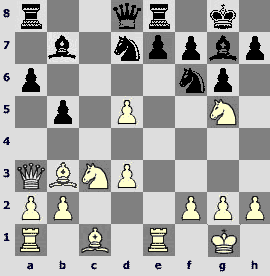
14...Јb6?! As a rule, Black chooses consistent 14...¤b6 and after 15.d6 e6 16.¤ge4 falls into thinking.
16...¤fd5? did not bring success so far, for example 17.Ґg5 f6 18.¤xd5 ¤xd5 19.Ґh4 a5 20.¤c5 Ґc6 21.¦xe6 (Zagrebelny – Al.Kharitonov, Moscow 2005) – White is two pawns up and he saves his queen after 21...b4 22.¦xe8+ Јxe8 23.Ґxd5+ Ґxd5 24.Јa4.
After 16...¤xe4 17.¤xe4 Ґxe4 18.dxe4 Ґe5 19.¦d1 Јh4 20.g3 Јxe4 Black obtained tolerable play in Macieja – Dominguez, Bermuda 2005, however, deserved attention 20.f4 Ґxf4 21.Ґxf4 Јxf4 22.Јc5.
Perhaps best of all showed itself 16...¤bd7 17.¤xf6+ ¤xf6 18.Јb4 Ґc6 19.Ґg5 h6 20.Ґh4 g5 21.Ґg3 Јb6 22.¤e4 ¤h5 with good counter-play, Kharikrishna – Dominguez, Bermuda 2005 (though the Cuban lost both cited games).
Computer insistently offers 14...¦c8. It occurred also, but seldom. Here we finish with general educational theory.
15.Ґe3. A carnage was fast in Rahman – Villamayor, Manila 1995: 15.Јb4 Јd6 16.Јh4 h5 17.¤xf7 ўxf7 18.¦e6 Јc5 19.Ґe3 Јc8 20.d6 ўf8 21.Ґf4 1-0. necessary was 15...h6 16.¤ge4, though without too much prospects for Black also. Brodsky's path to the upper hand happened to be thornier.
15...Јd6. In case of 15...b4 16.Ґxb6 bxa3 17.Ґd4 axb2 18.¦ab1 White is a pawn up. On the last try to launch tactical intrigues by 18...¦ab8 he calmly replies 19.¦e2.
16.Јxd6 exd6.
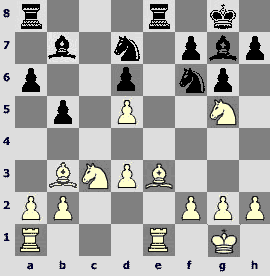
17.¤ce4! In case of less energetic continuation as 17.a3, Black obtains counter-play by 17...¤g4.
17...¤xe4 18.¤xe4 Ґxb2 19.¤xd6!? To our pleasure, Mikhail prefers more spectacular continuation. Maybe simpler is 19.¦ab1 Ґa3 (19...Ґe5 20.f4 Ґg7 21.¤xd6 ¦xe3 22.¦xe3 Ґd4 23.ўf2 does not make it easier) 20.Ґf4. In view of the threat Ґxd6 Black plays 20...Ґb4, and now in case of 21.¦e3 f5 22.Ґxd6 he has 22...¦xe4!, and if 22.¤xd6 then 22...Ґxd6 23.Ґxd6 ¤b6.
However, 21.¦ec1! fixes White's advantage. In the basic variation 21...f5 22.¤xd6 Ґxd6 23.Ґxd6 ¤f6 he wins by 24.Ґe7! ¤xd5 25.¦c7 ўg7 (25...ўh8 26.Ґc5! ¤xc7 27.Ґd4+) 26.¦xb7 ¤xe7 27.¦e1 ўf8 28.¦e6ќ.
19...Ґxa1 20.¦xa1. After 20.¤xe8 Ґe5 21.d4 Ґxh2+ 22.ўxh2 ¦xe8 23.d6 the endgame is difficult for Black.
20...¦eb8 21.¦c1. If Black further stands in a shapeless mass he will soon perish ingloriously.
21...¤f6 22.Ґg5! ¤e8. A decisive moment comes.
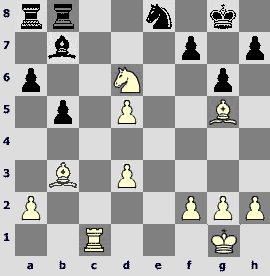
23.¤xf7! ўxf7 24.d6+ ўg7. In case of 24...ўf8 25.Ґh6+ ¤g7 26.¦c7 Black will be checkmated.
25.¦e1. At first moment hand stretches to play 25.d7!, but after 25...¤d6 (in case of 25...¤f6 26.d8Ј ¦xd8 27.¦c7+ everything is clear) doubts come to mind. Nevertheless, the passed pawn advancing is the strongest move.
First, let us consider 26.d8Ј ¦xd8 27.¦c7+ ўf8 28.¦xh7! The only reply of principle is 28...¦dc8, after which modern technologies allow prolonging a semi-forced variation for a dozen moves: 29.h4 (now White is threatening with check on e7 and capturing of the knight) 29...¦c6 30.Ґh6+! (in case of 30.Ґd5 ¦c1+ 31.Ґxc1 Ґxd5 32.¦d7 Ґxa2 33.¦xd6 Ґf7 chances to win are minimal) 30...ўe8 31.Ґe6! ¦c5 (if 31...Ґc8 then 32.Ґd5; very bad is 31...¦c3 32.Ґg5; Black should be ready to give away exchange on g5) 32.Ґd7+ ўd8 33.Ґe3 ¦ac8 (in case of 33...¦c6 retains advantage 34.Ґe6! ¤e4!, but not 34.Ґg5+ ўc7) 34.Ґxc8 ¦xc8 35.Ґg5+ ўe8 36.¦e7+ ўf8 37.¦d7 ¦c6 38.Ґf4 ўe8 39.¦xd6 ¦xd6 40.Ґxd6. It is time to stop. White has two extra pawns in a different-coloured bishops endgame, the passed d-pawn and future perspective to create another one on the h-file. There are good winning prospects from general considerations, but what thoughtful analysis could show – God only knows.
But all this is of little importance as White can continue his attack more powerfully:
26.¦c7! ўf8 (after 26...¦d8 27.Ґf4 White regains material without any positional losses) 27.Ґf4! ўe7 (27...¤f5 28.g4) 28.d8Ј+ ўxd8 29.¦xh7! (not 29.Ґxd6? ¦c8) 29...¦c8 (29...¤e8 30.Ґg5+ ўc8 31.Ґe6#) 30.Ґg5+ ўe8 31.Ґe6! ўf8 32.h4, and white wins in view of the threats Ґe7+ and Ґf6.
It is spectacular but sometimes too complicated. Brodsky attacked in an endgame without a rook by anthropomorphic means.
25...¤xd6. Hopeless is 25...h6 26.¦e7+ ўh8 27.Ґf4 ¤f6 28.Ґe5 ¦f8 29.¦xb7.
26.¦e7+ ўf8 27.¦xh7. Now 27...¦c8 leads to the position considered in the comments to the 25th move (after 25.d7 ¤d6 26.d8Ј). But the rook's location on b8 (in a poky hole of a place but not under attack!) gives Black an additional resource.
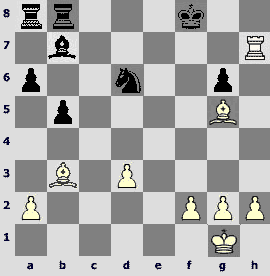
27...¤c4! 28.dxc4 bxc4 29.Ґc2. White does not want to test effectiveness of Black's counter-play in a sharp position after 29.Ґxc4 Ґd5 30.Ґd3 Ґxa2.
29...Ґd5 30.h4. On 30.Ґxg6 Black replies 30...¦b7, and White cannot play 31.¦h8+? ўg7 32.¦xa8 ўxg6 – both the bishop and the rook are hanging (¦b1+ and Ґxa8).
30...¦b7? The variation 30...¦b6 31.Ґh6+ ўg8 (31...ўe8 32.Ґa4+ ¦b5) 32.¦g7+ ўh8 33.Ґxg6 c3 34.h5 ¦c8 seems to lead to a clear draw: closeness of the c-pawn to the square of promotion forces White to perpetual checking. Now Black will have to play with lack of material.
31.¦h8+ Ґg8 32.Ґe4 ¦ab8 33.Ґh6+ ¦g7. 33...ўf7 loses because of intermediate 34.Ґd5+.
34.Ґd5. 34.Ґxg6 c3 is probably stronger, bur White does not want to take the risk. I would surmise a zeitnot.
34...ўe7 35.Ґxc4. The passed pawn getting on White's nerves is wiped out. The continuation 35.Ґxg7 ¦b1+ 36.ўh2 Ґxd5 did not possess this merit.
35...¦b1+ 36.ўh2 Ґxc4 37.Ґxg7 Ґxa2 38.h5 gxh5 39.¦xh5 ¦b5 40.¦h4.
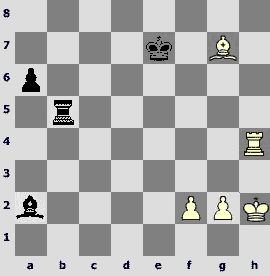
Black failed to cope with control in a simplified position.
40...ўf7. Simpler is 40...a5 41.Ґc3 Ґb3, putting the pawn under the protection of the bishop.
41.Ґc3 a5? After the mistake Black will lack two pawns.
42.¦h7+ ўg6 43.¦g7+ ўf5 44.¦a7 Ґd5 45.f3? In case of 45.Ґxa5 ¦b7 46.¦a6 ¦h7+ 47.ўg1 ¦g7 Black' initiative is sufficient for a draw. But white should play more subtly: 45.Ґe1! ¦b1 46.¦xa5 or 45...Ґc6 46.f3.
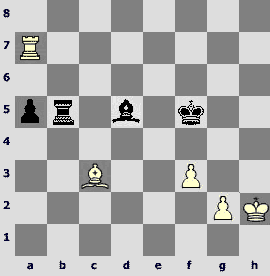
45...ўf4? Black could make use of the bishop location on the sane diagonal with the a-pawn by 45...¦b3, and White has to submit to the endgame 'R+B vs R' (46.Ґxa5 Ґxf3 47.¦f7+ ўe4) since in case of 46.¦xa5 ўe6 47.¦c5 ўd6 48.¦c8 ўd7 Black organizes perpetual attack.
46.Ґxa5 ¦b2. Alas, on 46...Ґxf3 follows 47.Ґc7+ ўg4 (or 47...ўe4) 48.¦a4+, and the last white pawn survives. If 46...¦b3 then 47.Ґd2+ ўf5 48.ўg3.
47.Ґc7+ ўf5 48.¦a5 ўe6 49.ўg3. White has to do a certain work to move his pawns from initial positions, but the task seems feasible even in case of the best defence.
49...¦a2 50.¦c5 ¦a4 51.¦c1 ¦a2 52.¦e1+ ўf7 53.Ґd6 ¦d2 54.Ґc5 ¦c2 55.Ґe3 ¦c3. more persistent is 55...Ґc6 56.¦g1 ¦c4.
56.ўf4 ¦c2.

57.g4. A big achievement of the stronger side: the pawns started on a journey remaining on light squares.
57...¦c4+ 58.ўg3 ¦c3 59.f4 Ґe4 60.f5 Ґd5 61.ўf4 ¦c4+ 62.ўg5 Ґf3 63.Ґf4 ¦c8 64.ўh4 ¦c4 65.ўg3 Ґe4 [65...¦c3 66.Ґe5 ¦b3 67.g5] 66.Ґe5 Ґd3 67.¦e3 Ґe4 68.¦a3 ўg8 69.¦a7 Ґd3 70.f6 ¦c6 71.f7+ ўf8 72.Ґb2. Black resigned. After 72...¦a6 73.Ґa3+ ¦xa3 74.¦xa3 he will be checkmated, as someone is reporting to me, no longer than in 17 moves.
The most interesting thing in the following game was one that merely would not take place if White were accurate to a minimal degree. If the phrase seems awkward and you cannot make sense of it, then look at the board. I recommend the game in any case though.
M.Roiz – Yu.Drozdovskij
Monarch Assurance, Isle of Man
1.d4 d5 2.c4 c6 3.¤c3 ¤f6 4.e3 a6 5.¤f3 e6 6.b3 Ґb4 7.Ґd2 Јe7 8.Ґd3 ¤bd7 9.0–0 0–0.
10.¤e5. More frequent is 10.Јc2 and a cunning invention by Ivan Sokolov 10.Јe1.
10...¤xe5 11.dxe5 ¤d7 12.f4 f6. After 12...dxc4 13.bxc4 Ґxc3 14.Ґxc3 ¤c5 15.Ґc2 b5 16.Јh5 h6 17.¦ad1 Black did not equalize in Najer – S.Ivanov, Moscow 2004.
13.Јc2 h6.
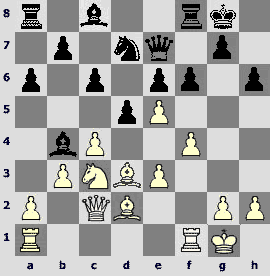
14.a3! The game Moiseenko – Kir.Georgiev came to an approximately equal position after 14.exf6 ¤xf6 15.ўh1 Ґd7 16.e4 d4 17.e5 dxc3 18.exf6 Јxf6 19.Ґe1 c5 20.a3 Ґa5 21.¦b1 Ґc6 22.b4 Ґc7 23.Ґxc3 Јh4 24.Ґe5 Ґxe5 25.fxe5.
14...Ґc5. Naïve 14...Ґxa3? leads to big troubles: 15.¦xa3! Јxa3 16.b4! The queen is cut off, and an attempt to escape capturing another pawn 16...Јxb4 would be punished by 17.¤xd5 Јc5 18.Ґb4 Јa7 19.¤e7+ ўh8 20.¤g6+ ўg8 21.¤xf8 Јxe3+ 22.ўh1 ¤xf8 23.exf6 gxf6 24.¦f3 with a decisive attack on the neglected king.
15.b4 Ґb6. The last guiding line is E.Vorobiov – Pokazanjev, Dagomys 2006, where after 15...Ґa7 16.exf6 ¤xf6 17.c5 e5 18.e4 b6 19.exd5 bxc5 20.Ґc4 ўh8 21.ўh1 ¤g4 (a probable alternative is 21...cxb4 22.fxe5 Јxe5 23.axb4 Ґd7) 22.h3 Ґf5 23.Ґd3 Ґxd3 24.Јxd3 cxb4 25.d6 Јh4 26.¤e4 White obtained a compensation for a pawn. Drozdovskij is ready to lose a tempo after c4-c5 but to locate his bishop on a convenient square from where it would control important squares and would not get underfoot of rooks. Still details of the plan happened to be not fully thought over.
16.exf6 ¤xf6 17.c5 Ґc7.
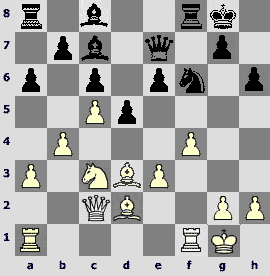
18.e4 e5? In case of exemplary 18...dxe4 19.¤xe4 (19.Ґc4 is hardly worthy) 19...¤d5 20.Ґc4 e5 21.¦ae1 White outstrips in finishing mobilization and gets advantage. However, the text move leads to a crash almost intermediately.
19.exd5 cxd5 20.fxe5 Ґxe5. Accomplishing strategically beneficial opening of the centre, Roiz provided for a following tactical nuance: 20...Јxe5 21.Ґf4! Јd4+ 22.ўh1 Ґxf4 23.¤e2. Wiping out the bishop on f4 on his way, the white knight makes for the tasty points g6, e6 and d5. White's advantage in development takes on a decisive nature.
21.¦ae1. The bishop is obviously bad as a shield for the queen against the enemy rook. A pawn would be quite better but it dashed forward untimely and perished.
21...Ґd7. If the queen tries to slip away then disunity of the rooks tells immediately: 21...Јc7? 22.¤xd5 ¤xd5 23.Ґh7+.
22.Ґf4 Ґd4+ 23.ўh1 Јd8. You can smile: 23...Јf7 24.Ґg6.
24.¤e2.
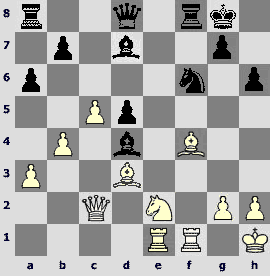
From bad to worse: the bishop is trapped.
24...¤h5 25.Ґg6. Having achieved everything he could wish, Michael relaxes. Stricter is 25.g3 ¤xf4 (25...Ґf6 26.Ґd6 Ґe7 27.¤f4) 26.¤xf4 ¦f6 27.Јb3! Ґc6 (27...ўh8 28.¤g6+) 28.¤e6.
25...¤xf4 26.¤xf4 ўh8 27.Јd1? The move protracts the game seriously now. If White wanted to let pass the bishop backward then 27.Јd2 would be preferable, and after 27...Јf6 28.Ґb1 even a short-term winning exchange will not help: 28...Ґc3 (in case of 28...ўg8 White may already retreat 29.Јd1! and then jump aside with his knight triumphantly) 29.Јe2 Ґxe1 30.¤g6+ Јxg6 31.Ґxg6 Ґb5 32.Ґd3 with a won position. But actually, the queen could just stay on its place: after 27.Ґd3! Black would have to capitulate in a few moves, the shelter of his king being very uncomfortable.
27...Ґc3 28.Ґc2. In case of 28.¦e3 d4 29.¦ef3 Black would continue struggling by 29...¦f6; worse is 29...Ґg4 30.¤e6! Ґxe6 31.¦xf8+ Јxf8 32.¦xf8+ ¦xf8 33.Ґd3.
28...¦xf4 29.¦xf4 Ґxe1 30.Јxe1.
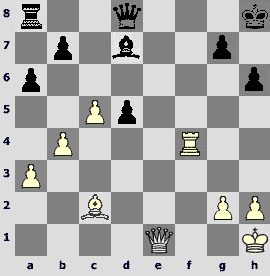
Black's chronic weakness did not disappear, but what a relief for him of trading two pairs of pieces!
30...Јe8 31.Јf2 ўg8. The purpose is to let go the queen bound by defending of the eighth rank.
32.h4 Јe5 33.Ґg6 Ґe6. Changes in position are not cardinal: Black is still in the pit. Stirring up by 33...a5 fails, for example 34.Јg3 Јa1+ 35.ўh2 axb4 36.axb4 Ґe8 (36...¦a3? 37.¦f8+! ўxf8 38.Јd6+ ўg8 39.Јb8+) 37.Ґc2 ¦a3 38.Ґb3.
34.Јg3 Јa1+ 35.ўh2 ўh8 36.Јe3 Ґg8 37.h5 a5.
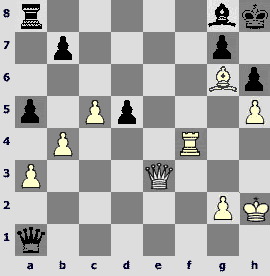
It is not a fruitful occupation to search for strengthening for Black on the interval between the two last diagrams. You can do nothing: the opponent dominates! Yuri somehow protected his king, threw his queen into the opponent's zone (it would be of little use in its own one anyway) and tries to place in a job his rook. However, his last move allows White to form a strong passed pawn.
38.b5! ¦c8 39.Ґf5 ¦f8. Even worse is 39...¦c7 40.Ґe6 (threatening with ¦f8) 40...Јd1 41.Ґg4 Јa1 42.Јe8.
40.c6 bxc6 41.bxc6 d4 42.Јe5 Јc1. Now, if White had played 43.¦g4 ¦f7 44.¦g6 here, then the game would not enter any top-list. It might follow 44...Јe3 (44...Ґh7 45.Јxd4) 45.Ґe4 (с7 threatens) 45...Јc1 (45...Јf4+ 46.Јxf4 ¦xf4 47.c7 ¦f8 48.Ґb7) 46.Ґd5, and it would be time to sign the scoresheets. But a small proud pawn broke away from its collective and flied to meat its dream.
43.c7.
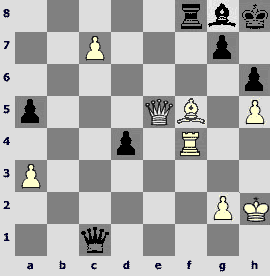
43...¦e8! 44.Јd6 ¦e1 45.c8Ј. White has a queen for a pawn, but Black never breathed so freely in this game.
45...¦h1+ 46.ўg3 Јe1+ 47.¦f2 Јe3+ 48.¦f3 Јg5+. 48...Јe1+ 49.ўf4 Јh4+ 50.Ґg4 transposes the moves.
49.Ґg4 Јh4+ 50.ўf4 Јg5+. In case of 50...Јh2+ 51.¦g3 ¦f1+ 52.Ґf3 Јh4+ 53.Јg4 the white king is surrounded by attentive bodyguards.
51.ўg3 Јh4+ 52.ўf4 Јg5+.

53.ўe4. The king has to set off for a journey, evading shells exploding all around.
53...¦e1+ 54.ўxd4. The exception method is working: 54.ўd3? Јb5+.
54...Јd2+. Black has no choice also: 54...¦d1+ 55.¦d3.
55.ўc5 (55.¦d3?? Јf2+ 56.ўc3 ¦c1#) 55...¦c1+ 56.ўb5 Јxd6. Checks come to an end much sooner in case of 56...¦b1+ 57.ўc6 ¦b6+ (57...¦c1+ 58.ўd7) 58.ўxb6 Јxd6+ 59.ўb7 Јd5+ 60.Јc6.
57.Јxc1. A new material proportion – White is a rook up.
57...Јb8+ 58.ўa6 Јa8+ 59.ўb6 Јb8+ 60.ўc6 Јe8+. In case of 60...Јa8+ 61.ўc7 Јa7+ 62.ўd8 the white king would find quarters at last where to summon its army up: 62...Јd4+ 63.Ґd7; 62...Јb8+ 63.Јc8.
61.ўc7 Јe5+ 62.ўd8 Јd5+ 63.ўc7?! His Majesty is too enthusiastic about his promenade. 63.Ґd7 is much simpler.
63...Јe5+ 64.ўc8 Јe8+ 65.ўb7 Јe4+. Bringing up the bishop 65...Ґd5+ seemingly must add power to a lonely attack of the queen, but it turns out that in the variation 66.ўc7 Јe5+ 67.ўd7 the joint forces are lacking co-ordination. 66...Јe7+ 67.Ґd7 Јe5+ 68.ўc8 Ґxf3 69.gxf3 Јxh5 70.Јe3 does not save the situation also.

66.ўb8? It is obvious tiredness. White should give away his bishop anyway, so why not approach the queen? After 66.Јc6 Јxg4 67.¦f8 there are no more checks, transition into a pawn endgame is seen in some distance, and Black cannot seize the pawn on h5 because of 68.Јc4. The graceful variation 66...Ґd5 67.¦f8+ ўh7 68.Ґf5+ is simple even for the zeitnot.
66...Јe5+? A final mistake. Black should minimize his material deficiency: 66...Јxg4 67.Јc5 Јxg2 68.¦f8. Even if the position is lost, one could find many opportunities to make the opponent's head boil.
67.Јc7 Јb2+ 68.ўc8 Јxg2 69.Јg3 Јc2+ 70.¦c3 Јe4 71.Ґf3 Ґe6+ 72.ўb8 Јd4 73.Јc7. Black resigned.
The above games entered the top ten, though with small amounts of points. The duel Shirov – Laznicka shared 11th place with Aronian – Grischuk, and it would be just to include it to my review, but I realized I would not be able to comment another 70-move game, sorry for that. Besides, this game played in Karlovy Vary does not fit announced sea themes.
V.Malakhatko – J.Speelman
Monarch Assurance, Isle of Man
1.d4 e6 2.c4 b6 3.a3 Ґb7 4.¤c3 ¤f6 5.¤f3 d5 6.cxd5 ¤xd5 7.e3 Ґe7 8.Ґb5+ c6 9.Ґd3 0–0 10.e4 ¤xc3 11.bxc3 c5 12.0–0 cxd4. Let me not to dazzle you by names of chessplayers who used to employ 12...¤c6 and 12...¤d7. Believe me, these are good moves.
13.cxd4.
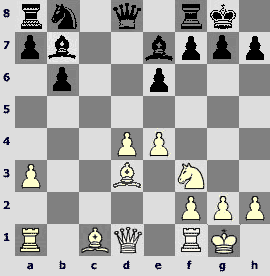
13...Ґa6. Here 13...¤c6 is quite possible too. Speelman thinks it is more important to exchange the opponent's light-squared bishop and believes the fact that his knight goes to the edge of the board at the same time to be a transient inconvenience. There is a single example on the subject among titled chessplayers' games: Malakhatko – Cosma, Marseille 2004.
14.Ґxa6 ¤xa6 15.Јe2 Јc8 16.Ґf4 Јb7 17.¦fd1 ¦ad8. Cosma equalized gradually by means of 17...¦fd8 18.h4 ¦ac8 19.h5 h6 20.¦d3 ¤c7 21.¤e5 ¤e8 22.¦e1 Ґf6 23.Јf3 Ґxe5 24.Ґxe5 f6 25.Ґf4 Јf7. I do not know whether Speelman have seen the game or he acted by intuition, but I cannot call his plan intelligible.
18.¦d3 Ґd6 19.Ґg5. Generally speaking, it is to White's benefit to leave only knights on the board in such structure, so 19.Ґxd6 ¦xd6 20.¦ad1 deserved attention. However, Malakhatko guessed right retreating with his bishop.
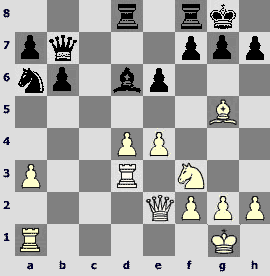
19...¦c8? Black should change outlines of play by 19...f6. And how it is now? Black occupied the c-file with his rook in two steps having spent a valuable tempo to transfer his bishop to d6 where it most likely will meet е4-е5.
20.¦ad1 ¦fe8 21.h4. After 21.e5 Ґf8 (perhaps 21...Ґe7 22.Ґxe7 Јxe7 23.¤d2 is better but it is a pity to give away the d6 point) 22.¤d2 ¤c7(22...¦c2 only pushes white pieces to battle positions: 23.Јg4 ¤c7 24.¤e4 ¤d5 25.Ґf6 with a destructive attack) 23.¤e4 ¤d5 White can obtain a position from the game by playing 24.h4 if he wants. But he has a lot of more high-principled and tempting continuations in his possession: 24.¦g3, 24.¦h3, 24.Јg4 or 24.Јh5. So, 21.e5 was the most natural and strong. In case of 21.¤d2 Black cannot play 21...h6 22.Ґxh6! gxh6 23.e5, and White's offensive develops automatically, and on 21...¤c7 good is 22.¦h3. However, Black might reply 21...e5.
21...¤c7? Missing the last opportunity for a move like 21...f5!, Black concedes to oppression on the kingside.
22.e5. White trades the e4 square for d5.
22...Ґf8 23.¤d2 ¤d5 24.¤e4 h6. The move would deserve a question mark but it is difficult to propose anything instead. Even having the h-file blocked White easily pumps pressure on the black king's position (Јg4, ¦g3, h5, Ґf6).

25.¤f6+? Now a pattern of the battle changes sharply. Meanwhile simple 25.Ґxh6! leaves no chances for Black to escape in case of both 25...f5 26.exf6 gxh6 27.Јh5 and 25...gxh6 26.¦g3+ ўh8 27.Јg4 ¤e7 28.h5 and then ¤f6. Well, in the game we got, after various adventures, a spectacular and unusual finale instead.
25...¤xf6. Of course, self-undressing of the king led to a catastrophe: 25...gxf6 26.Ґxf6 ¤xf6 (26...¤f4 27.¦g3+ ¤g6 28.h5) 27.exf6 ўh8 28.Јg4, and Black must quickly prepare to give away his queen for the rook on g3.
26.Ґxf6 Јc6. The board is cleared, and an opportunity appears for major black pieces to come to the rescue of their king. They can reach the opponent's attacking units from the c-line.
27.Јg4 Јc2 28.¦1d2. 28.¦g3? is parried by 28...¦c3.
28...Јb1+ 29.¦d1? Better is 29.ўh2 ¦c1 30.d5 exd5 31.¦xd5.
29...¦c1 30.¦xc1.
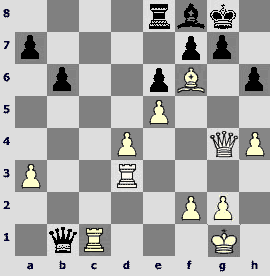
30...Јxd3? This rook looked more dangerous, but the impression is wrong. Correct is 30...Јxc1+! 31.ўh2 ¦c8 32.¦g3 ¦c3, and White's attack stalls off: 33.f3 Јe3! 34.Ґxg7 h5! 35.Јxh5 Ґxg7 36.Јg4 Јh6. Neutralizing of the c-rook activity turns out significantly more difficult.
31.h5. Preventing the manoeuvre 31...Јg6.
31...Јxa3 32.¦c7 Јd3. So the 'official' game text reads. I see no reasons to reject capture 33.¦xa7 in the position. I suppose that the real moves order was 32...a5 33.Ґh4 (with the idea Јf4) 33...Јd3.
33.Ґh4 a5 34.ўh2. On 34.Јf4? Black would reply not with thoroughly prepared 34...Јf5, but with rather rough 34...Јd1+ 35.ўh2 Јxh5, removing all questions about the result of the game.
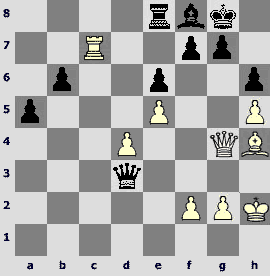
34...¦a8. Let us check straightforward 34...a4 35.d5!
a) In case of 35...Јxd5?! 36.Јf4 f5 37.exf6 it is Black who must look for a draw. After 37...Ґd6 38.f7+ ўh7 39.fxe8Ј Ґxf4+ 40.Ґg3 Ґxc7 41.Ґxc7 he is a pawn down. Correct is 37...¦a8 38.Јg3 Ґd6 39.¦xg7+ ўh8 40.f4 Јf5 41.f7 Ґxf4 42.¦g8+ ўh7 43.¦g7+ with perpetual check;
b) very dangerous is 35...exd5? 36.Јd7;
с) the main line is 35...a3 36.Јf4 Јf5 37.Јxf5 exf5 38.d6 a2 (in case of 38...f6 39.f4 ¦a8 40.d7 a2 41.¦c8 a1Ј 42.d8Ј ¦xc8 43.Јxc8 Black should display some accuracy) 39.d7 (will not do 39.¦a7? ¦xe5 40.d7 ¦a5, and after exchanges and promotions White will not have Ґe7 due to the check from e5) 39...¦d8 (we shall consider the position after 39...¦a8 40.¦c1! a little later; on 39...¦xe5 40.d8Ј a1Ј there is 41.Ґf6! gxf6 42.Јxf6 or 41...¦e8 42.Јxe8 Јxf6, and Black loses an exchange; though he can hardly fear for the outcome of the game) 40.Ґxd8 a1Ј 41.Ґf6 gxf6 42.d8Ј Јxe5+ 43.g3 f4 – the white king is exposed and the game must end by perpetual check.
35.Јf4 Јf5 36.Јxf5 exf5 37.d5 a4 38.d6 a3. We have seen the position after 38...f6 39.f4 a3 already in the 'c' subparagraph above (first brackets).
39.d7 a2.
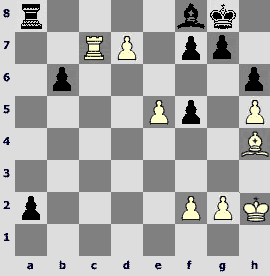
40.¦c1! This timely coming back on the control move not only saves White but makes his opponent (who probably foretasted easy realization of his advantage after 40.¦c8? a1Ј) to switch to searching for defence.
40...f6. On 40...Ґc5 follows not 41.d8Ј+ ¦xd8 42.Ґxd8 Ґd4, but 41.¦a1!
41.exf6 ўf7? The sharp turn unhorsed Black. Correct was 41...Ґc5 42.fxg7 (42.¦a1 Ґd6+ and 43...Ґc7) 42...ўxg7 43.d8Ј ¦xd8 44.Ґxd8 Ґd4 45.Ґxb6 a1Ј 46.¦xa1 Ґxa1, and if I am not missing some etude niceties, Black would be able to make a draw in this bishop ending.
42.¦c8! The circumstances have changed, and the rook rushes up the board!
42...a1Ј. After 42...Ґd6+ 43.g3 Ґxg3+ wins both 44.Ґxg3 and 44.ўg2.
43.d8Ј ¦xc8. 43...Јe5+ 44.Ґg3 does not change the outcome, but after the text move we shall feel aesthetic pleasure. I am switching off the light and going away, leaving you alone with the fascinating picture.
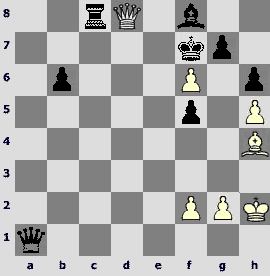
44.Јd5+! ўe8 45.f7#!

Discuss in forum